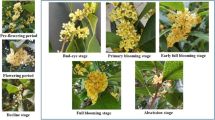Abstract.
The genes of two closely related 12-oxophytodienoic acid reductases (EC 1.3.1.42), OPR1 and OPR2, were identified on a 7079-bp-long genomic fragment from Arabidopsis thaliana (L.) Heynh. The organization of these two genes was determined and putative cis elements were identified. Promoter-β-glucuronidase (GUS) fusions expressed in transgenic Arabidopsis thaliana and Nicotiana tabacum L. plants revealed differences in OPR-promoter-driven GUS expression in flowers. While the OPR1 promoter directed GUS expression in young seeds, the OPR2 promoter directed pollen-specific expression. Both OPR1 and OPR2, were predominantly expressed in roots. Stress treatments, like local and systemic wounding, UV-C illumination and coldness, resulted in transient changes in steady-state OPR mRNA levels, but no concurrent changes in polypeptide level or enzyme activity were detected.
Similar content being viewed by others
Author information
Authors and Affiliations
Additional information
Received: 2 October 1998 / Accepted: 22 December 1998
Rights and permissions
About this article
Cite this article
Biesgen, C., Weiler, E. Structure and regulation of OPR1 and OPR2, two closely related genes encoding 12-oxophytodienoic acid-10,11-reductases from Arabidopsis thaliana . Planta 208, 155–165 (1999). https://doi.org/10.1007/s004250050545
Issue Date:
DOI: https://doi.org/10.1007/s004250050545




